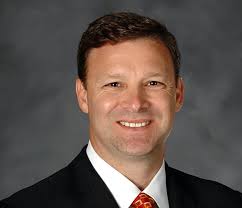Florida’s power companies should not be setting energy policy for the state.
Yet that essentially will happen Tuesday if the Florida Public Service Commission (PSC) undermines a longstanding state law on energy conservation.
Every five years, Florida law requires the PSC to set energy conservation goals for the state’s biggest utilities. In 2014, Florida Power & Light and the state’s other big utilities persuaded the commission to cut their goals by 90 percent. Now they’re back asking for goals of zero or nearly zero.
Last week, the PSC staff recommended the commission approve the utilities’ proposals. Staff acknowledged that approval in some cases would mean ending goals — and incentives — for energy conservation programs for homeowners. The staff recommendation sided with the utilities who say they have better, more cost-effective ways to cut energy use.
FPL CEO Eric Silagy defended this approach during a recent meeting with the Sun Sentinel Editorial Board. Through a program called Demand-Side Management, FPL customers agree to turn off air conditioners, water heaters and pool pumps when power demand peaks. This approach, he said, is more predictable in helping the utility manage power needs. He said it has prevented the need to build 14 power plants.

Silagy disagrees with giving customers rebates to install new windows, water heaters and air conditioners. He said rebates are gifts to people who would or should make such purchases anyway. He said the bulk of FPL customers — who pay $1.50 per month toward the conservation program — don’t make such improvements, and thus “subsidize the few.”
But that $1.50 is among the lowest of the state’s major utilities. And except for those in the business of selling electricity, we’ve heard no outcry from FPL customers against energy-conservation rebates and other programs.
And if the issue is fairness, let’s remember that FPL charged all customers to seek licenses for two additional nuclear reactors at Turkey Point in Miami-Dade County that it now doesn’t plan to build.
The company also plans to charge all customers for the undergrounding of power lines, even people who already enjoy underground lines.
Silagy is right that a rebate is a gift to someone whose air conditioner breaks down. But that rebate might spur cash-strapped families to buy a more expensive, higher-efficiency model that would further reduce their bill over the years. And that, in turn, would help all FPL customers — and our environment — by slowing the demand for electricity and the need for more monster power plants.
Silagy notes that energy efficiency has improved over the years, not only because of steps the company has taken, but because today’s building codes reduce energy waste in buildings.
That’s great news. But now is no time to ease up. Now is the time to set stretch goals for an industry leader like FPL.
If not incentives to buy energy-saving lightbulbs — an example Silagy uses, though FPL hasn’t offered this for years — what about incentives for longer-term investments, like wall insulation, energy-saving windows or cool roofs?
And how about helping renters save money on their electric bills by encouraging the owners of multifamily properties to insulate pipes, install solar water heaters, or weatherize roofs, windows and sliding glass doors?
And how about helping low-income people in leaky older houses reduce energy consumption?
Meaningful goals — stretch goals — might spur energy conservation programs that lift all homes.
But Tuesday’s discussion will not be driven by practical ways to reduce energy consumption. Rather, the discussion will highlight a formula that weighs incentives against their impact on rates. And the Rate Impact Measure, or RIM cost-benefit test — which only Florida uses — suggests conservation goals are no longer cost-effective.
The push to end conservation goals is the latest attempt by FPL and other utilities to steer energy policy. In 2016, the utilities spent $26 million to promote a deceptive constitutional amendment that would have put them in charge of solar energy. The amendment failed.
Despite our differences with FPL, the company is good for the state in many ways. Bills are relatively low, which encourages business to expand and move here.
As Silagy points out, FPL has spent many billions in the last decade on generating plants — at Port Everglades, the Port of Palm Beach and elsewhere — that are much more efficient. They use natural gas, which burns cleaner than oil and especially coal. Fort Lauderdale, with its decaying water and sewage systems, could take a lesson from FPL about the need for capital improvement.
Yet FPL’s business model depends on generating more power and building more power plants. When a power plant begins operations, the base rate rises. The base rate is the source of FPL’s profits. As a regulated monopoly, FPL is guaranteed profits of up to 11.5 percent.
FPL bills have remained stable because the price of natural gas — about 70 percent of its fuel — is down almost 800 percent since the mid-2008 spike. But if gas prices — which have been historically volatile — rise, so will bills.
Susan Glickman is Florida director of the Southern Alliance for Clean Energy. The group regularly opposes FPL before the PSC and did so on the energy conservation issue.

Glickman agrees that FPL’s rates are relatively low. She adds, though, “They could be lower still.” She says Floridians pay the eighth highest power bills in the country.
Glickman says Florida ranks near the bottom for energy conservation, and will rank even lower if the commission sides with the utilities.
If FPL and the other utilities want to change energy policy, they should seek to do so through the Legislature. There would be public debate and a chance for compromise among all parties.
And after spending more than $8 million on political contributions in the last election cycle — far more than any other entity we know — FPL would surely get what it wants. It almost always does.
So for the first time on Tuesday, expect the Florida Public Service Commission to approve conservation goals of zero for some investor-owned utilities.
If that happens, customers might save $1.50 monthly on the front end. But given the threat of sea-level rise and the climate crisis — worsened by the burning of fossil fuels — the state will lose a lot more.
This editorial, written by the Sun Sentinel Editorial Board, is part of the “The Invading Sea” collaboration of four South Florida media organizations — the Sun Sentinel, Miami Herald, Palm Beach Post and WLRN Public Media.



